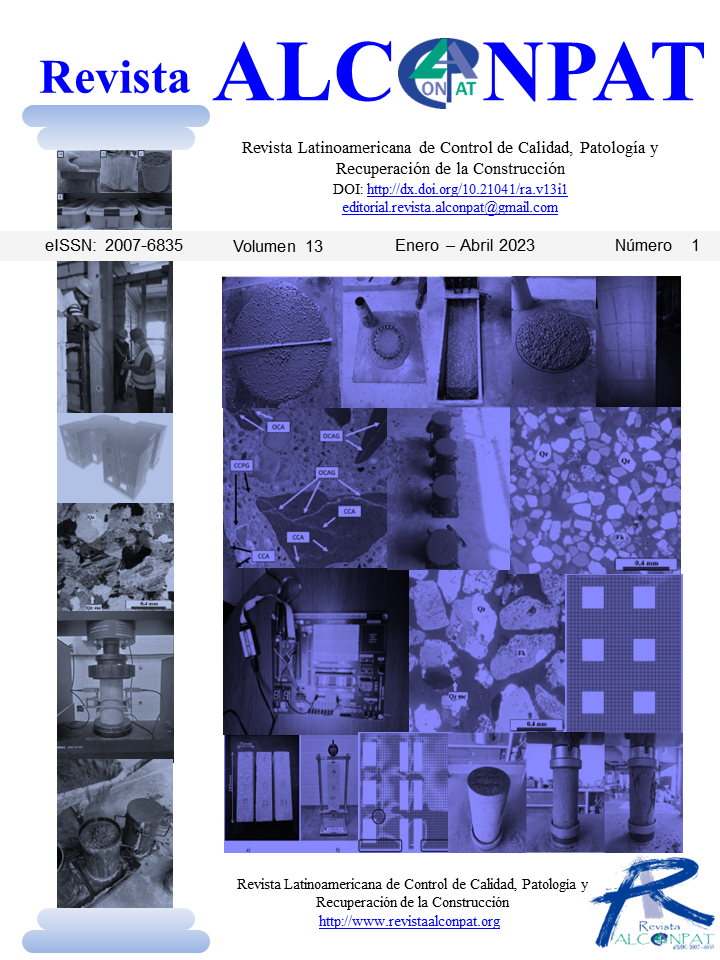Systematic review on alkali-aggregate reactions: comparative overview of studies carried out in Canada and Brazil
DOI:
https://doi.org/10.21041/ra.v13i1.628Keywords:
alkali-aggregate reaction; durability; expansive reactions; Canada; BrazilAbstract
The objective of this research is to compare the performance of Canada and Brazil in studies related to alkali aggregate reaction (AAR) in concrete, through a qualitative, quantitative and systematic review of the literature, in addition to using the VOS viewer software for co-analysis. citation and bibliographic coupling. The collected data indicate that Canada is the country that most stands out in terms of research on AAR in the world, Brazil is in the seventh position. The work presented the research centers between the two countries, the existing methodologies for assessing AAR and the panorama of research on the subject in Brazil. Finally, the work showed that among the emerging themes about AAR and knowledge gaps.
Downloads
References
Associação Brasileira De Normas Técnicas. (2018). NBR 15577: Agregados - Reatividade álcali-agregado Parte 7: Determinação da expansão em prismas de concreto pelo método acelerado. Rio de Janeiro.
Associação Brasileira De Normas Técnicas. (2018). NBRE15577: Agregados - Reatividade álcali-agregado Parte 6: Determinação da expansão em prismas de concreto. Rio de Janeiro.
Adams, D. F., Walrath, D. E. (1987). Current status of the Iosipescu shear test method, J. Compos. Mater. 21: 494–507. https://doi.org/10.1177/002199838702100601
Adorno, C. S., Langaro, E. A., Medeiros, M. H. F., Gobbi, A. (2020). Teste acelerado de argamassas e a combinação de adições minerais ativas com agregado potencialmente reativo. Journal of Urban Technology and Sustainability. 3: 36-50. https://doi.org/10.47842/juts.v3i1.23
Adorno, C. S., Medeiros, M. H. F., Filho, J. H., Réus, G. C. (2018). Effects of the addition of red ceramic, limestone filler and rice husk ash in alkali silica reaction. Journal of Building Pathology and Rehabilitation. 3: 1-11. https://doi.org/10.1007/s41024-017-0030-0
Alaejos, P., Lanza, V., Bermúdez, M. A., Velasco, A. (2014). Effectiveness of the accelerated mortar bar test to detect rapid reactive aggregates (including their pessimum content) and slowly reactive aggregates. Cement and Concrete Research. 58: 13–19. https://doi.org/10.1016/j.cemconres.2014.01.001
Andrade Neto, J. S., França, M. J. S., Amorim Júnior, N. S., Véras Ribeiro, D. (2021). Effects of adding sugarcane bagasse ash on the properties and durability of concrete. Construction and Building Materials. 266: 120959. https://doi.org/10.1016/j.conbuildmat.2020.120959
Angulo-Ramírez, D. E., Gutiérrez, R. M., Medeiros, M. H. F. (2018). Alkali-activated Portland blast furnace slag cement mortars: Performance to alkali-aggregate reaction. Construction and Building Materials. 179: 49-56. https://doi.org/10.1016/j.conbuildmat.2018.05.183
Berubè, M. A., Dorion, J., Duchesne, J., Fournier, B., Vezinac, D. (2003b). Laboratory and field investigations of the influence of sodium chloride on alkali–silica reactivity. Cement and Concrete Research. 33: 77–84. https://doi.org/10.1016/S0008-8846(02)00926-2
Berubè, M. A., Duchesne, J., Dorion, J. F., Rivest, M. (2002). Laboratory assessment of alkali contribution by aggregates to concrete and application to concrete structures affected by alkali–silica reactivity. Cement and Concrete Research. 32: 1215–1227. https://doi.org/10.1016/S0008-8846(02)00766-4
Berubè, M. A., Duchesne, J., Ollivier, J. P., Ballivya, G. (2003). Alkali mass balance during the accelerated concrete prism test for alkali–aggregate reactivity. Cement and Concrete Research 33: 1147–1153. https://doi.org/10.1016/S0008-8846(03)00020-6
Bérubé, M. A., Smaoui, N., Bissonnette, B., Fournier, B. (2005). Outil d’évaluation et de gestion des ouvrages d’art affectés de réactions alcalis-silice (RAS). Études et Recherches en Transport, Ministère des Transports du Québec.Canadá.
Beyene, M., Snyder, A., Lee, R. J., Blaszkiewicz, M. (2013). Alkali Silica Reaction (ASR) as a root cause of distress in a concrete made from Alkali Carbonate Reaction (ACR) potentially susceptible aggregates. Cem. Concr. 51: 85–95. https://doi.org/10.1016/j.cemconres.2013.04.014
Blight, G. E., Mciver, J. R., Schulte, W. K., Rimmer, R. (1981). “The effects of alkali–aggregate reaction on reinforced concrete structures made with Witwatersrand quartzite aggregate”. 5th ICAAR — International Conference on Alkali–Aggregate Reaction in Concrete, Cape Town, South Africa.
Bolotte, B. (1992). “Development of an accelerated performance test on concrete for evaluating its resistance to AAR.” The 9th International Conference on Alkali–Aggregate Reactivity in Concrete. United Kingdom, London.
Broekmans, M. A. T. M. (2002). “The Alkali – Silica Reaction: Mineralogical and Geochemical Aspects of some Dutch Concretes and Norwegian Mylonites”, PhD Thesis, Utrecht University, The Netherlands.
Campos, A., López, C. M., Blanco, A., Aguado, A. (2018). Effects of an internal sulfate attack and an alkali-aggregate reaction in a concrete dam. Construction and Building Materials. 166: 668-683. https://doi.org/10.1016/j.conbuildmat.2018.01.180
Chrisp, T. M., Waldron, P., Wood, J. G. (1993). Development of a non-destructive test to quantify damage in deteriorated concrete. Magazine of Concrete Research. 45 (165): 247–256. https://doi.org/10.1680/macr.1993.45.165.247
Clemena, G. G., Lane, S., Freeman, T., Lozev, M. (2000). Evaluation of Nondestructive Evaluation Methods for Application in Early Detection of Deterioration in Concrete Pavements. VTRC 00-R13 Virginia Transportation Research Council, Charlottesville, USA.
Crouch, R. S., Wood, J. G. M. (1990). Damage evolution in ASR affected concretes. Eng. Fract. Mech. 35: 211–218.
De Carvalho, M. R. P., Faisbain, E. M. R., Filho, R. D. T., Cordeiro, G. C., Hasparyk, N. P. (2010). Influence of steel fibers on the development of alkali-aggregate reaction. Cement and Concrete Research. 40(4): 598-604. https://doi.org/10.1016/j.cemconres.2009.11.007
De Souza, D. J., Sanchez, L. F. M., De Grazia, M. T. (2019). Evaluation of a direct shear test setup to quantify AAR-induced expansion and damage in concret. Constr. Build. Mater. 229: 116806. https://doi.org/10.1016/j.conbuildmat. 116806.
Degrosbois, M., Fontaine, E. (2000). “Performance of the 60 °C-Accelerated Concrete Prism Test for the evaluation of potential alkali–reactivity of concrete aggregates”. The 11th International Conference on Alkali–Aggregate Reactivity in Concrete. Quebec City, QC, Canada.
Drolet, C., Duchesne, J., Fournier, B. (2017). Effect of alkali release by aggregates on alkali-silica reaction. Construction and Building Materials. 157: 263–276. https://doi.org/10.1016/j.conbuildmat.2017.09.085
Drolet, C., Duchesne, J., Fournier, B. (2017). Validation of the alkali contribution by aggregates to the concrete pore solution. Cement and Concrete Research. 98: 10–23. https://doi.org/10.1016/j.cemconres.2017.04.001
Duchesne, J., Berubè, M. A. (2001). Long-term effectiveness of supplementary cementing materials against alkali–silica reaction. Cement and Concrete Research. 31: 1057–1063. https://doi.org/10.1016/S0008-8846(01)00538-5
Dunbar, P.A., Grattan-Bellew, P. E. (1995). “Results of damage rating evaluation of condition of concrete from a number of structures affected by ASR”. CANMET/ACI International Workshop on Alkali–Aggregate Reactions in Concrete, Darmouth, Canada. pp. 257-266.
Feng, X., Thomas, M. D. A., Bremner, T. W., Folliard, K. J., Fournier, B. (2010). Summary of research on the effect of LiNO3 on alkali–silica reaction in new concrete. Cement and Concrete Research. 40: 636–642. https://doi.org/10.1016/j.cemconres.2009.08.021
Fiset, M., Sanchez, L. F. M., Bilodeau, S., Mitcell, D., Bastien, J. (2021). Influence of Alkali-Silica reaction (ASR) on aggregate interlock and shear-friction behavior of reinforced concrete members. Engineering Structures. 233: 111890. https://doi-org.ez48.periodicos.capes.gov.br/10.1016/j.engstruct.2021.111890
Fournier, B., Bérubé, M.-A. (2000). Alkali-aggregate reaction in concrete: a review of basic concepts and engineering implications. Canadian Journal of Civil Engineering. 27(2): 167–191. https://doi.org/10.1139/l99-072
Fournier, B., Bérubé, M. A., Folliard, K., Thomas, M. D. A. (2010). Report on the diagnosis, prognosis, and mitigation of alkali-silica reaction (ASR) in transportation structures. US Department of Transportation, Federal Highway Administration, Publication FHWA-HIF-09-004.
Fournier, B., Chevrier, R., Degrosbois, M., Lisella, R., Folliard, K., Ideker, J., Shehata, M., Thomas, M., Baxter, S. (2004). “The accelerated concrete prism test (60 °C): variability of the test method and proposed expansion limits”. The 12th International Conference on Alkali–Aggregate Reaction in Concrete, Beijing China.
Gallo, G., Sanchez, L., Medeiros, M. H. F., Andrade, T. (2007). Medidas preventivas para a reação álcali-agregado (RAA) no concreto. Concreto & Contruções. 46: 22-28.
Glänzel, W. (2003). “Bibliometrics as a research field: a course on theory and application of bibliometric indicators”. Course handouts .Bélgica.
Golmakani, F., Hooton, R. (2016). “Comparison of laboratory performance tests used to assess alkali-silica reactivity”. Proceedings, Annual Conference - Canadian Society for Civil Engineering. 2: 1–7.
Grattan-Bellew, P. E., Cybanski, G., Fournier, B., Mitchell, L. (2003). Proposed Universal Accelerated Test for Alkali-Aggregate Reaction The Concrete Microbar Test. Cement. Concrete, and Aggregates. 25: 2.
Grattan-Bellew, P. E., Danay, A. (1992). “Comparison of laboratory and field evaluation of AAR in large dams Proc. of the International Conference on Concrete AAR in Hydroelectric”. Plants and Dams, Canadian Electrical Association & Canadian National Committee of the Int. Commission on Large Dams, Fredericton New Brunswick, Canada.
Grattan-Bellew, P. E., Mitchell, L. D. (2006). “Quantitative petrographic analysis of concrete — The Damage Rating Index (DRI) method, a review Proc”. Marc-André Bérubé Symposium on AAR in Concret. CANMET/ACI Advances in Concrete Technology Seminar, Montréal, Canada, 1: 321-334.
Gorga, T., Sanchez, L. F. M., Martín-Pérez, B. (2018). FE approach to perform the condition assessment of a concrete overpass damaged by ASR after 50 years in service. Engineering Structures. 177: 133-146. https://doi.org/10.1016/j.engstruct.2018.09.043
Golmakani, F. R., Hooton, D. (2019). Impact of pore solution concentration on the accelerated mortar bar alkali-silica reactivity test. Cement and Concrete Research. 121: 72-80. https://doi.org/10.1016/j.cemconres.2019.02.008
Haskett, M., Oehlers, D. J., Mohamed Ali, M. S., Sharma, S. K. (2011). Evaluating the shear-friction resistance across sliding planes in concrete. Eng. Struct. 33: 1357–1364. https://doi.org/10.1016/j.engstruct.2011.01.013.
Hasparyk, N. P., Monteiro, P. J., Molin, D. C. C. (2009). Investigation of mechanical properties of mass concrete affected by alkali-aggregate reaction. Journal of Materials in Civil Engineering. 21: 294:297. https://doi.org/10.1016/j.cemconres.2009.11.007
Hasparyk, N. P., Sanchez, L. F. M. (2021).“SDT – Método de ensaio para a determinação do índice de dano de rigidez (SDI) e índice de deformação plástica (PDI) em concretos”. Instrução técnica ITDSBE001. FURNAS. Gôiania. Brasil. p. 19.
Hjørland, B. (2013). Citation analysis: A social and dynamic approach to knowledge organization. Information Processing and Management. 49: 1313–1325. https://doi.org/10.1016/j.ipm.2013.07.001
Ideker, J. H., East, B. L., Folliard, K. J., Thomas, M. D. A., Fournier, B. (2010). The current state of the accelerated concrete prism test. Cement and concrete research. 40(4): 550-555. https://doi.org/10.1016/j.cemconres.2009.08.030
Johnson, C. V., Chen, J., Hasparyk, N. P., Monteiro, P. J. M., Akono, A. T. (2017). Fracture properties of the alkali silicate gel using microscopic scratch testing. Cement and Concrete Composites. 79: 71-75. https://doi.org/10.1016/j.cemconcomp.2017.01.012
K. J. Murdock, K. J., Blanchette, A. (1994). Rapid evaluation of alkali–aggregate reactivity using a 60 °C concrete prism test. The 3 rd International Conference on Durability of Concrete. Nice, France.
Katayama, T., Grattan-Bellew, P. E. (2012). “Petrography of the Kingston experimental sidewalk at age 22 years--ASR as the cause of deleteriously expansive, socalled alkali-carbonate reaction”. in: Proc. 14th Int. Conf. Alkali-Aggregate React. Concr. Austin, Texas, USA.
Katayama, T., Jensen, V., Rogers, C. A. (2016). The enigma of the ‘so-called’ alkali-carbonate reaction. Proc. Inst. Civ. Eng. Constr. Mater. 169(4): 223-232. https://doi.org/10.1680/jcoma.15.00071
Kermit, P. H. (2017). “Determining alkali content in ASR performance-tested concrete”. Master of Science in Engineering and ICT. Norwegian University of Science and Technology. Department of Structural Engineering. p.72.
Kubo, Y., Nakata, M. (2012). “Effect of reactive aggregate on mechanical properties of concrete affected by alkali-silica reaction”. In: Proceedings of the 14th international conference on alkali-aggregate reaction in concrete. Austin. Texas. Electronic.
Lindgård, J. (2011). “Literature survey on performance testing”. RILEM TC 219-ACS-P. p. 164.
Lindgard, J., Andiç-Cakir, O., Fernandes, I., Ronning, T., Thomas, M. D. A. (2012). Alkali–silica reactions (ASR): Literature review on parameters influencing laboratory performance testing. Cement and Concrete Research. 42: 223–243. https://doi.org/10.1016/j.cemconres.2011.10.004
Lindgård, J., Fournier, B., Ronning, T. F., Thomas, M. D. A. (2016). Alkali–aggregate reaction: performance testing, exposure sites and regulations Proceedings of the Institution of Civil. Engineers Construction Materials. 169: 189-196. https://doi.org/10.1680/jcoma.15.00077
Lindgard, J., Sellevold, E. J., Thomas, M. D. A., Pedersen, B.; Justnes, H.; Ronning, T. (2013). Alkali–silica reaction (ASR)—performance testing: Influence of specimen pre-treatment, exposure conditions and prism size on concrete porosity, moisture state and transport properties. Cement and Concrete Research. 53: 145–167. https://doi.org/10.1016/j.cemconres.2013.05.020
Lindgard, J., Skjolsvold, O., Haugen, M., Hagelia, P., Wigum, B. J. (2004). “Experience from evaluation of degree of damage in fluorescent impregnated plan polished sections of half-cores based on the “Crack Index Method”. 12th ICAAR — International Conference on Alkali–Aggregate Reaction in Concrete. Beijing, China. pp. 939-947.
Lindgard, J., Thomas, M. D. A., Sellevold, E. J., Pedersen, B., Andiç-Cakir, O., Justnes, H., Ronning, T. (2013). Alkali–silica reaction (ASR)—performance testing: Influence of specimen pre-treatment, exposure conditions and prism size on alkali leaching and prism expansion. Cement and Concrete Research. 53: 68–90. https://doi.org/10.1016/j.cemconres.2013.05.017
Lu, D., Mei, L., Xu, Z., Tang, M., Fournier, B. (2006). Alteration of alkali reactive aggregates autoclaved in different alkali solutions and application to alkali–aggregate reaction in concrete (I) Alteration of alkali reactive aggregates in alkali solutions. Cement and Concrete Research. 36: 1176–1190. https://doi.org/10.1016/j.cemconres.2006.01.008
Lu, D., Zhou, X., Xu, Z., Lan, X., Tang, M., Fournier, B. (2006). Evaluation of laboratory test method for determining the potential alkali contribution from aggregate and the ASR safety of the Three-Gorges dam concrete. Cement and Concrete Research. 36: 1157–1165. https://doi.org/10.1016/j.cemconres.2006.01.004
Lucas, E. O., Garcia-Zorita, J. C., Sanz-Casado, E. (2013). Evolução histórica de investigação em informetria: ponto de vista espanhol. Liinc em Revista. 9 (1): 255-270. https://doi.org/10.18617/liinc.v9i1.509
Mariano, A. M., Rocha, M. S. (2017). “Revisão da literatura: apresentação de uma abordagem integradora”. XXVI Congreso Internacional AEDEM. Reggio Calabria. Italia.
Martin, R. P., Sanchez, L., Fournier, B., Toutlemonde, F. (2017). Evaluation of different techniques for the diagnosis & prognosis of Internal Swelling Reaction (ISR) mechanisms in concrete. Construction and Building Materials. 156: 956–964. https://doi.org/10.1016/j.conbuildmat.2017.09.047
Munhoz, G. S., Dobrovolski, M. E. G., Pereira, E., Medeiros Junior, R. (2021). Effect of improved autogenous mortar self-healing in the alkali-aggregate reaction. Cement and Concrete Composites.117: 103905. https://doi.org/10.1016/j.cemconcomp.2020.103905
Naar, R. (2010). “Modelisation du comportement mécanique du béton par approche multi-physique (couplage chimie-mécanique): application à la réaction alcalisilice”. Thèse de doctorat. École Nationale Supérieure des Mines de Paris (France).
Noel, M., Sanchez, L., Tawil, D. (2019). Structural implications of internal swelling reactions in concrete: review and research needs. Magazine of concrete research. 70(20): 1052-1063. https://doi.org/10.1680/jmacr.17.00383
Prado, R. J., Tiecher, F., Hasparyk, N. P., Dal Molin, D. C. C. (2019). Structural characterization of alkali-silica reaction gel: Na x-ray absorption fine structure study. Cement and Concrete Research. 123: 105774. https://doi.org/10.1016/j.cemconres.2019.05.019
Pragalath, H., Seshathiri, S., Rathod, H., Balasubramanian Esakki, S. M. A. S. C. E. (2018). Deterioration Assessment of Infrastructure Using Fuzzy Logic and Image Processing Algorithm.
Journal of Performance of Constructed Facilities. 32: 1-13. 10.1061/(ASCE)CF.1943-5509.0001151
Ranc, R., Debray, L. (1992). “Reference test methods and a performance criterion for concrete structures”. The 9th International Conference on Alkali-Aggregate Reaction in Concrete. London.
Rivard, P., Berubè, M. A., Ollivier, J. P., Ballivy, G. (2007). Decrease of pore solution alkalinity in concrete tested for alkali-silica reaction. Materials and Structures. 40:909–921. https://doi.org/10.1617/s11527-006-9191-z
Rivard, P., Fournier, B., Ballivy, G. (2000). Quantitative petrographic technique for concrete damage due to ASR: experimental and application. Cem Concr Aggreg. 22 (1):63-72. https://doi.org/10.1520/CCA10465J
Salomon, M., Panetier, J. L. (1994). “Quantification du degré d'avancement de l'alcali-réaction dans les bétons et de la néofissuration associée”. 3rd CANMET/ACI International conference on durability of concrete. Nice, France. pp. 383-401.
Sanchez, L. F. (2014). “Contribution to the assessment of damage in aging concrete infrastructures affected by alkali-aggregate reaction”. Tese (Doutorado) — Université Laval. p. 377.
Sanchez, L. F. M., Fournier, B., Jolin, M., Bastien, J., Mitchell, D. (2017). Tools for assessing damage in concrete affected by AAR coming from fine and coarse aggregates. Revista Ibracon De Estruturas E Materiais. 10:84-91. https://doi.org/10.1590/S1983-41952017000100005
Sanchez, L. F. M., Fournier, B., Jolin,M., Mitchell, D., Bastien, J. (2017). Overall assessment of Alkali-Aggregate Reaction (AAR) in concretes presenting different strengths and incorporating a wide range of reactive aggregate types and natures. Cem. Concr. Res. 93: 17–31. https://doi.org/10.1016/j.cemconres.2016.12.001
Sanchez, L., Kuperman, S. C., Helene, P. (2011). Uso do método acelerado brasileiro de prismas de concreto (ABCPT) para avaliação da reação álcali-agregado (RAA). Revista Ibracon de Estruturas e Materiais (RIEM). 4(4):575–581. https://doi.org/10.1590/S1983-41952011000400004
Sanchez, L. F. M., Fournier, B., Jolin, M., Bastien, J. (2015). Evaluation of the Stiffness Damage Test (SDT) as a tool for assessing damage in concrete due to alkali-silica reaction (ASR): Input parameters and variability of the test responses. Construction and Building Materials. 77: 20–32. https://doi.org/10.1016/j.conbuildmat.2014.11.071
Sanchez, L. F. M., Fournier, B., Jolin, M., Bastien, J. (2014). Evaluation of the stiffness damage test (SDT) as a tool for assessing damage in concrete due to ASR: Test loading and output responses for concretes incorporating fine or coarse reactive aggregates. Cement and Concrete Research. 56: 213–229. https://doi.org/10.1016/j.cemconres.2013.11.003
Sanchez, L. F. M., Fournier, B., Jolin, M., Bastien, J., Mitchell, D. (2016). Practical use of the Stiffness Damage Test (SDT) for assessing damage in concrete infrastructure affected by alkali-silica reaction. Construction and Building Materials. 125: 1178–1188. https://doi.org/10.1016/j.conbuildmat.2016.08.101
Sanchez, L. F. M., Fournier, B., Jolin, M., Duchesne, J., Bedoya, M. A. B., Bastien, J. (2016). Use of Damage Rating Index to Quantify Alkali-Silica Reaction Damage in Concrete: Fine versus Coarse Aggregate. ACI MATERIALS JOURNAL. 113: 395-407. http://dx-doi.ez48.periodicos.capes.gov.br/10.14359/51688983
Sanchez, L. F. M., Fournier, B., Jolin, M., Duchesne, J. (2015). Reliable quantification of AAR damage through assessment of the Damage Rating Index (DRI). Cement and Concrete Research. 67: 74–92. https://doi.org/10.1016/j.cemconres.2014.08.002
Sanchez, L. F. M., Fournier, B., Jolin, M., Mitchell, D., Bastien, J. (2017). Overall assessment of Alkali-Aggregate Reaction (AAR) in concretes presenting different strengths and incorporating a wide range of reactive aggregate types and natures. Cement and Concrete Research. 93: 17–31. https://doi.org/10.1016/j.cemconres.2016.12.001
Sanchez, L. F. M., Fournier, B., Jolin, M., Bastien, J., Mitchell, D. (2017). Tools for assessing damage in concrete affected by AAR coming from fine and coarse aggregates. Rev. IBRACON Estrut. Mater. 10(1): 84-91. https://doi.org/10.1590/S1983-41952017000100005
Santos, B. S., Ribeiro, D. V. (2021). Influence of granitic rock fines addition in the alkali-aggregate reaction (AAR) in cementitious materials. Revista Ibracon De Estruturas E Materiais. 14: 14203. https://doi.org/10.1590/S1983-41952021000200003
Shehata , H. S. M., Thomas, M. D. A. (2006). Alkali release characteristics of blended cements. Cement and Concrete Research. 36: 1166–1175. https://doi.org/10.1016/j.cemconres.2006.02.015
Shehata , H. S. M., Thomas, M. D. A. (2002). Use of ternary blends containing silica fume and fly ash to suppress expansion due to alkali–silica reaction in concrete. Cement and Concrete Research. 32: 341–349. https://doi.org/10.1016/S0008-8846(01)00680-9
Shehata, H. S. M., Thomas, M. D. A. (2000). The effect of fly ash composition on the expansion of concrete due to alkali–silica reaction. Cement and Concrete Research. 30:1063– 1072. https://doi.org/10.1016/S0008-8846(00)00283-0
Shehata, H. S. M., Thomas, M. D. A. (2010). The role of alkali content of Portland cement on the expansion of concrete prisms containing reactive aggregates and supplementary cementing materials. Cement and Concrete Research. 40: 569–574. https://doi.org/10.1016/j.cemconres.2009.08.009
Shon, C. S. C.-S., Zollinger, D. G., Sarkar, S. L. (2002). Evaluation of modified ASTM C 1260 accelerated mortar bar test for alkali-silica reactivity. Cement and Concrete Research. 32(12):1981–1987. https://doi.org/10.1016/S0008-8846(02)00903-1
Silva, C. S., Santos, M., Monteiro, E. C. B.; Andrade, T. W. C. O.; Soares, W.; Neves, D. (2021). Recovery procedures for foundation elements with alkali/aggregate reaction problems. Documental research. Revista ALCONPAT. 11(2): 124–145. https://doi.org/10.21041/ra.v11i2.490
Sims, I., Hunt, B., Miglio, B. (1992). “Quantifying microscopical examinations of concrete for AAR and other durability aspects”. Am Concr Inst. Idorn international symposium. Annual ACI convention. Toronto. Ontario. Canada. 131–114, pp. 267-287.
Skolu, S. O., Thomas, M. D. A., Hooton, R. D. (2007). Dual effectiveness of lithium salt in controlling both delayed ettringite formation and ASR in concretes. Cement and Concrete Research. 37: 942–947. https://doi.org/10.1016/j.cemconres.2007.01.014
Smaoui, N., Bérubé, M. A., Fournier, B., Bissonnette, B., Durand, B. (2004). Evaluation of the xpansion attained to date by concrete affected by alkali-silica reaction. PartI: Experimental study. Canadian Journal of Civil Engineering. 31(5): 826–845. https://doi.org/10.1139/l04-104
Thomas, M. D. A., Folliard, K. J. (2007). “Concrete aggregates and the durability of concrete”. Durab. Concr. Cem. Compos. 247–281. https://doi.org/10.1533/9781845693398.247
Thomas, M., Fournier, B., Folliard, K., Ideker, J., Shehata, M. (2006). Test methods for evaluating preventive measures for controlling expansion due to alkali-silica reaction in concrete. Cement and Concrete Research. 36,(10):1842–1856. https://doi.org/10.1016/j.cemconres.2006.01.014
Tiecher, F., Dal Molin, D. C. C., Gomes, M. E. B., Hasparyk, N. P., Monteiro, P. J. M. (2012). Influence of mesostasis in volcanic rocks on the alkali-aggregate reaction. Cement and Concrete Composites. 34(10): 1130-1140. https://doi.org/10.1016/j.cemconcomp.2012.07.009
Tiecher, F., Gomes, M. B., Dal Molin, D. C. C. (2018). Alkali-Aggregate Reaction: A Study of the Influence of the Petrographic Characteristics of Volcanic Rocks. Engineering, Technology & Applied Science Research. 8(1): 2399-2404. https://doi.org/10.48084/etasr.1731
Tiecher, F., Dal Molin, D. C. C., Gomes, M. E. B., Hasparyk, N. P., Monteiro, P. J. M. (2017). Relationship between degree of deformation in quartz and silica dissolution for the development of alkali-silica reaction in concrete. Materials. 10(9): 1022. https://doi.org/10.3390/ma10091022
Touma, W. E., Fowler, D. W., Carrasquillo, R. L. (2001). “Alkali–silica reaction in portland cement concrete: testing methods and mitigation alternatives”. Report ICAR 301–1F. International Center for Aggregates Research, Austin, Texas.
Walsh, J. B. (1965). The effect of cracks on the uniaxial elastic compression of rocks. J Geophys Res. 70:399–411. https://doi.org/10.1029/JZ070i002p00399
Xue, L., Zang, Z., Wang, H. (2021). Hydration mechanisms and durability of hybrid alkaline cements (HACs): A review. Construction and Building Materials. 266: Part A, 121039. https://doi.org/10.1016/j.conbuildmat.2020.121039
Zhu, Y., Zahedia, A., Sanchez, L. F.M., Fournier, B., Beaucheminc, S. (2021). Overall assessment of alkali-silica reaction affected recycled concrete aggregate mixtures derived from construction and demolition waste. Cement and Concrete Research. 142: 106350. https://doi.org/10.1016/j.cemconres.2020.106350
Downloads
Published
How to Cite
Issue
Section
License
_______________________________
License in effect from September 2020
You are free to:
- Share — copy and redistribute the material in any medium or format for any purpose, even commercially.
- Adapt — remix, transform, and build upon the material for any purpose, even commercially.
- The licensor cannot revoke these freedoms as long as you follow the license terms.
Under the following terms:
- Attribution — You must give appropriate credit , provide a link to the license, and indicate if changes were made . You may do so in any reasonable manner, but not in any way that suggests the licensor endorses you or your use.
- No additional restrictions — You may not apply legal terms or technological measures that legally restrict others from doing anything the license permits.
Notices:
You do not have to comply with the license for elements of the material in the public domain or where your use is permitted by an applicable exception or limitation .
No warranties are given. The license may not give you all of the permissions necessary for your intended use. For example, other rights such as publicity, privacy, or moral rights may limit how you use the material.





















.png)














